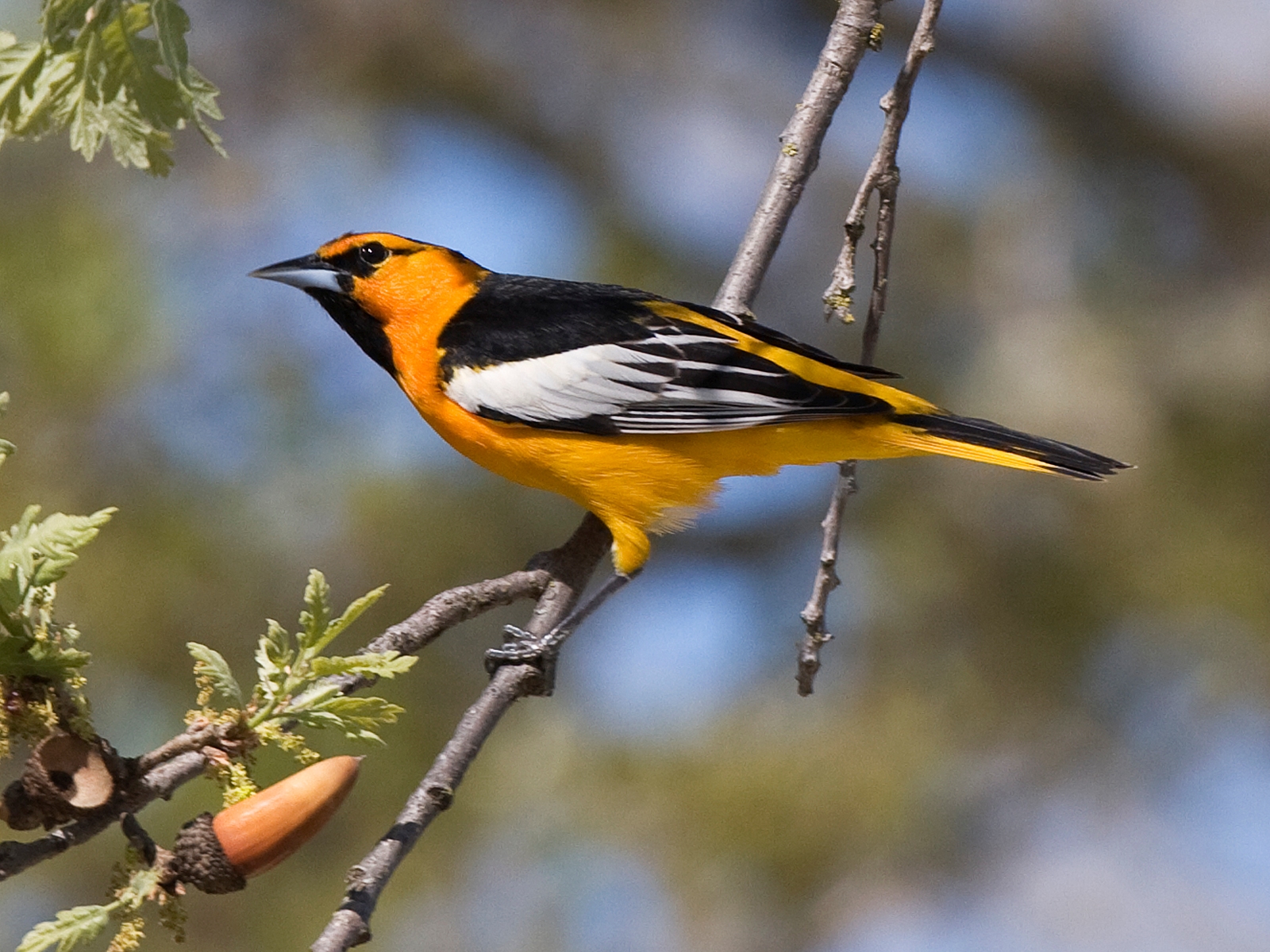- Icterid
Taxobox
name = Icterids

image_caption =Bullock's Oriole
regnum =Animal ia
phylum = Chordata
classis = Aves
ordo = Passeriformes
subordo =Passeri
familia = Icteridae
familia_authority = Vigors,1825
subdivision_ranks = Genera
subdivision = 24, see textThe Icterids are a group of small to medium, often colourful
passerine bird s restricted to theNew World . Most species have black as a predominant plumage colour, often enlivened by yellow, orange or red. The name, meaning "jaundiced ones" (from the prominent yellow feathers of many species) comes from theAncient Greek "ikteros", through theLatin "ictericus". This group includes the New World blackbirds,New World orioles , theBobolink ,meadowlark s, grackles,cowbird s,oropendola s and caciques.Despite the similar names, the first groups are not related to the
Old World Blackbird (a thrush, Turdidae), or the Old Worldoriole s (Oriolidae).Characteristics
The majority of icterid species live in the tropics, although there are a number of temperate forms, such as American Blackbirds and the
Long-tailed Meadowlark . The highest densities of breeding species are found inColombia and SouthernMexico . [Lowther P (1975) "Geographic and Ecological Variation in the Family Icteridae" "Wilson Bulletin" 87 (4): 481-495] They inhabit a range of habitats, including scrub, swamp, forest, and savannah. Temperate species are migratory, with many species that nest in the United States and Canada moving south into Mexico and Central America.Icterids are variable in size, and often display considerable
sexual dimorphism . For example, the maleGreat-tailed Grackle is 60% heavier than the female. The smallest icterid species is theOrchard Oriole at 15 cm in length and 18 grams in weight, while the largest is theOlive Oropendola , at 52 cm and 445 grams. This variation is greater than in any otherpasserine family (unless theKinglet Calyptura belongs with thecotinga s, which would then have greater variation [cite book | last = Prum | first = Richard O. | coauthors = Snow, David W. | year = 2003 | title = Firefly Encyclopedia of Birds | chapter = Cotingas | editor =Christopher Perrins (Ed.) | pages = 432–433 | publisher = Firefly Books | id = ISBN 1-55297-777-3] ). One of the more unique morphological adaptations shared by the icterids is gaping, where the skull is configured to allow them open their bills strongly rather than passively, allowing them to force open gaps to obtain otherwise hidden food.Icterids have adapted to taking a wide range of foods. Oropendolas and caciques use their gaping motion to open the skins of fruit to obtain the soft insides, and have long bills adapted to the process. Others like cowbirds and the Bobolink have shorter stubbier bills for crushing seeds. The
Jamaican Blackbird uses its bill to bry amongst tree bark and epiphytes, and has adopted the evolutionary niche usually filled bywoodcreeper s. Orioles will also drink nectar.The nesting habits of these birds are similarly variable, including pendulous weaved nests in the oropendolas and orioles. Many icterids are colonial, nesting in colonies of up to 100,000 birds. Some cowbird species engage in brood parasitism, where females lay their eggs in the nests of other species, in a similar fashion to some
cuckoo s.cite book |editor=Forshaw, Joseph|author= Parkes, Kenneth C.|year=1991|title=Encyclopaedia of Animals: Birds|publisher= Merehurst Press|location=London|pages= 214-215|isbn= 1-85391-186-0]Some species of icterid have become agricultural
pest s, for exampleRed-winged Blackbird s in the United States are considered the worst vertebrate pest to some crops likerice . [Dolbeer, R & S Ickes (1994) "Red-winged Blackbird feeding preferences and response to wild rice treated with Portland cement or plaster" "Vertebrate Pest Conference Proceedings collectionProceedings of the Sixteenth Vertebrate Pest Conference (1994)" (W.S. Halverson& A.C. Crabb, Eds.) Univ. of Calif.:Davis.] The cost of controlling blackbirds in California was 30/acre in 1994. Not all species have been as successful, and a number of species are threatened withextinction . These include insular forms such as the Jamaican Blackbird and theSt Lucia Oriole , which are threatened byhabitat loss .Systematics
FAMILY ICTERIDAE
*Genus "Dolichonyx " - Bobolink
*Genus "Agelaius " - Typical American blackbirds (11 species)
*Genus "Nesopsar " - Jamaican Blackbird
*Genus "Sturnella " - meadowlarks (7 species)
*Genus "Xanthocephalus " - Yellow-headed Blackbird
*Genus "Dives" (3 species)
*Genus "Euphagus " (2 species)
*Genus "Quiscalus " - true grackles (5 living species, 1 recentlyextinct )
*Genus "Agelaioides " - Bay-winged Cowbird (formerly in "Molothrus")
*Genus "Molothrus " - true cowbirds (5 species, includes "Scaphidura")
*Genus "Icterus" - New World orioles (25-30 species)
*Genus "Amblycercus " - Yellow-billed Cacique
*Genus "Ocyalus " - Band-tailed Oropendola (might include "Clypicterus")
*Genus "Clypicterus " - Casqued Oropendola
*Genus "Cacicus " - true caciques (c.10 species)
*Genus "Psarocolius " - true oropendolas (about 10 species, includes "Gymnostinops")
*Genus "Gymnomystax " - Oriole Blackbird
*Genus "Pseudoleistes " - marshbirds (2 species)
*Genus "Amblyramphus " - Scarlet-headed Blackbird
*Genus "Hypopyrrhus " - Red-bellied Grackle
*Genus "Curaeus " (2 species)
*Genus "Gnorimopsar " - Chopi Blackbird
*Genus "Oreopsar " - Bolivian Blackbird
*Genus "Lampropsar " - Velvet-fronted Grackle
*Genus "Macroagelaius " (2 species)Prehistoric icterid genera that have been described from
Pleistocene fossil remains are "Pandanaris " fromRancho La Brea and "Pyelorhamphus " fromShelter Cave .References
* (1999): "New World Blackbirds". Christopher Helm, London. ISBN 0-7136-4333-1
* (2002): A robust phylogeny of the oropendolas: Polyphyly revealed by mitochondrial sequence data. "Auk" 119(2): 335–348. DOI: 10.1642/0004-8038(2002)119 [0335:ARPOTO] 2.0.CO;2 [http://www.smcm.edu/users/jjprice/PDFs/Price%20&%20Lanyon%202002a.pdf PDF fulltext]External links
* [http://ibc.hbw.com/ibc/phtml/familia.phtml?idFamilia=203 Icterid videos] on the Internet Bird Collection
* [http://tolweb.org/Icteridae/67292 Icteridae at the Tree of Life Web Project]
Wikimedia Foundation. 2010.
